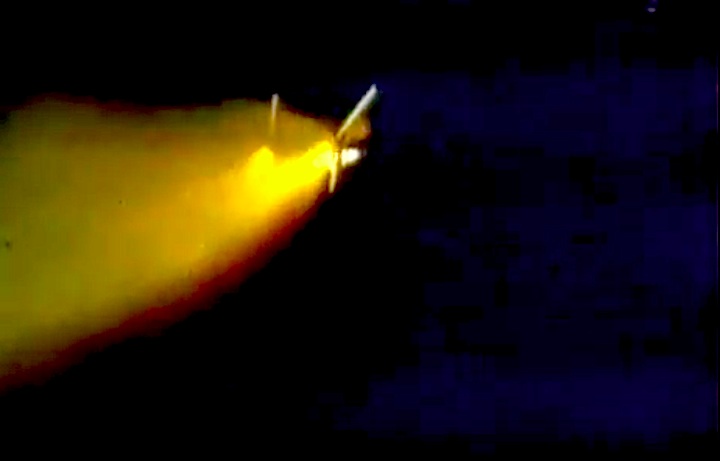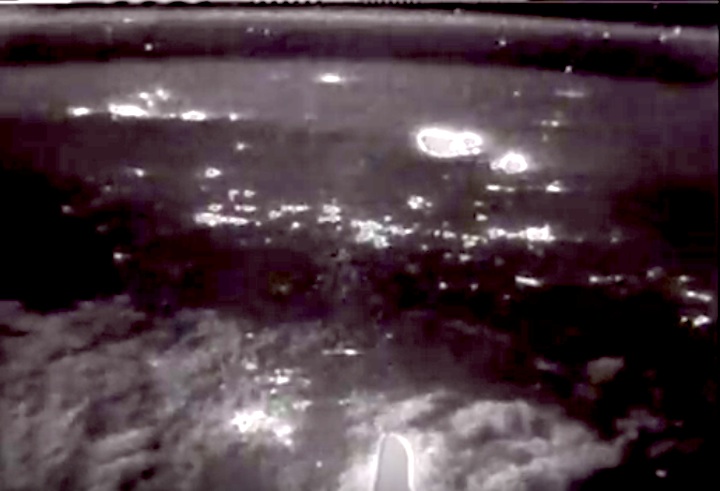.

STS-39
Space Shuttle: Discovery
Launch Pad: 39A
Launch Weight: 247,373 pounds
Launched: April 28, 1991, 7:33:14 a.m. EDT
Landing Site: Kennedy Space Center, Florida
Landing: May 6, 1991, 2:55:37 p.m. EDT
Landing Weight: 211,512 pounds
Runway: 15
Rollout Distance: 9,235 feet
Rollout Time: 56 seconds
Revolution: 134
Mission Duration: 8 days, 7 hours, 22 minutes, 23 seconds
Orbit Altitude: 190 nautical miles
Orbit Inclination: 57 degrees
Miles Traveled: 3.5 million
Crew Members

Image above: STS-39 Crew photo with Commander Michael L. Coats, Pilot L. Blaine Hammond, Mission Specialists Guion S. Bluford Jr., Gregory J. Harbaugh, Richard J. Hieb, Donald R. McMonagle and Charles L. Veach. Image Credit: NASA
Launch Highlights
 The launch was originally scheduled for March 9, but during processing work at Pad A, significant cracks were found on all four lug hinges on the two external tank umbilical door drive mechanisms. NASA managers opted to roll back the vehicle to the VAB on March 7, and then to OPF for repair. Hinges were replaced with units taken from orbiter Columbia, and reinforced. Discovery returned to the pad on April 1, launch was re-set for April 23. The mission was again postponed when, during prelaunch external tank loading, a transducer on the high-pressure oxidizer turbopump for main engine number three showed readings out of specification. The transducer and its cable harness were replaced and tested. Launch was rescheduled for April 28.
The launch was originally scheduled for March 9, but during processing work at Pad A, significant cracks were found on all four lug hinges on the two external tank umbilical door drive mechanisms. NASA managers opted to roll back the vehicle to the VAB on March 7, and then to OPF for repair. Hinges were replaced with units taken from orbiter Columbia, and reinforced. Discovery returned to the pad on April 1, launch was re-set for April 23. The mission was again postponed when, during prelaunch external tank loading, a transducer on the high-pressure oxidizer turbopump for main engine number three showed readings out of specification. The transducer and its cable harness were replaced and tested. Launch was rescheduled for April 28.Mission Highlights
Dedicated Department of Defense mission. An unclassified payload included Air Force Program-675 (AFP675); Infrared Background Signature Survey (IBSS) with Critical Ionization Velocity (CIV), Chemical Release Observation (CRO) and Shuttle Pallet Satellite-II (SPAS-II) experiments; and Space Test Payload-1 (STP-1). Classified payload consisted of Multi-Purpose Release Canister (MPEC). Also on board was Radiation Monitoring Equipment III (RME III) and Cloud Logic to Optimize Use of Defense Systems-IA (CLOUDS-I).
---

STS-39 | Shuttle: Discovery | Launch: April 28, 1991
From left to right: Charles L. Veach (mission specialist), Donald R. McMonagle (mission specialist), Gregory J. Harbaugh (mission specialist), Michael L. Coats (commander), L. Blaine Hammond (pilot), Richard J. Hieb(mission specialist) Guion S. Bluford, Jr. (mission specialist)
From left to right: Charles L. Veach (mission specialist), Donald R. McMonagle (mission specialist), Gregory J. Harbaugh (mission specialist), Michael L. Coats (commander), L. Blaine Hammond (pilot), Richard J. Hieb(mission specialist) Guion S. Bluford, Jr. (mission specialist)

After almost two months of delays, Discovery roars into orbit on 28 April 1991, 25 years ago, this week. Her STS-39 mission marked the longest shuttle flight ever conducted for the Department of Defense. Photo Credit: NASA, via Joachim Becker/SpaceFacts.de

The Infrared Background Signature Survey (IBSS), attached to a deployable Shuttle Pallet Satellite (SPAS), was one of the principal payloads aboard STS-39. The eight-day flight was the longest shuttle mission ever conducted in support of the Department of Defense. Photo Credit: NASA, via Joachim Becker/SpaceFacts.de


"Aurora from Space" STS-39 Crew, NASA

Explanation: A background of distant stars, sinuous and spiky bands of Southern Lights (Aurora Australis), and the faint glow of charged plasma (ionized atomic gas) surrounding the Space Shuttle Discovery's engines give this photo from the STS-39 mission an eerie, otherworldly look. This image reflects Discovery's April 1991 mission well - its payload bay (PLB) was filled with instruments designed to study celestial objects, aurora and atmospheric phenomena, and the low Earth orbit environment around the PLB itself. The aurora seen here are at a height of about 50-80 miles. Aurora are caused by charged particles in the solar wind, channeled through the Earth's magnetic field which excite molecules in the upper atmosphere.
---
Frams von STS-39 Discovery Mission NASA-Video:























Aurora-Aufnahmen






Gewitter-Zellen






















































Quelle: NASA
3966 Views
